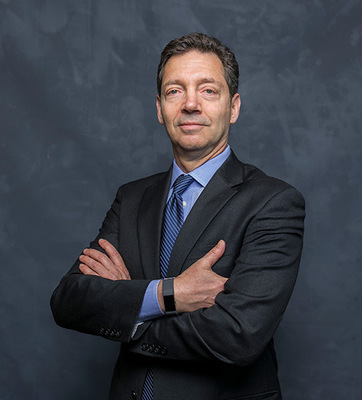John Tobin-de la Puente is bridging the gap between private investment and conservation

Plant growing from coin jar
John Tobin-de la Puente, professor of practice at Dyson, is on a mission to bring about positive environmental change through the power of private investment. From teaching and conducting research at Cornell, to co-founding a coalition to explore new investment models, he is passionate about helping to close the current conservation-funding gap and educating others about the value and benefits of deploying private, return-seeking capital in the service of environmental sustainability.

Tobin, an expert in corporate sustainability practices, conservation finance, and impact investing, holds a joint appointment at the Charles H. Dyson School of Applied Economics and Management and the Cornell Institute for Public Affairs in the College of Human Ecology. Tobin supports undergraduate and graduate-level courses related to impact investing, sustainable finance, and corporate sustainability, which has become a growing sector in the business world and is a key area of focus for Dyson. Driven to provide actionable solutions for environmental conservation, Tobin says he enjoys motivating students to learn how to do business in a manner that generates economic, environmental, and social returns.
Understanding the impacts of financial activity on the environment
Sustainable finance is an umbrella term for the practice of finance that considers environmental, social, and governance (ESG) factors.
ESG involves risk management and revenue generation. Investors can practice sustainable finance by minimizing risks associated with finance activity. For instance, “There is a pretty wide understanding that palm oil has a negative impact on the environment, so you can elect not to finance actors in the palm oil industry that do not apply sustainable production methods,” says Tobin.
However, sustainable finance for revenue generation goes beyond merely avoiding the risks and instead intentionally focusing on the positive impacts of sustainable practices. For instance, considering products or services that not only allow for a return, but also provide benefits to society and the environment.
Sustainable finance, Tobin explains, is not to be confused with impact investing. “Impact investing is more openly and unabashedly intentional. It’s investing in a manner that is intended to have a clear positive impact. Returns, for some impact investors, is almost a secondary consideration, and it’s the positive impact that is the primary focus of the activity,” he says.
Connecting the dots between conservation and finance
Getting at the heart of sustainable finance and identifying how to leverage it was a bit of a long and winding road for Tobin, who was initially more attracted to biology at the start of his career.
Tobin began his career in pursuit of a PhD in tropical ecology. Through fieldwork, he became aware that there was an increasing need for intervention in order to protect the environment. “I realized that basic research was not going to have a direct and immediate impact on anyone other than a few researchers, and potentially a handful of students taking my classes, but I wanted to have a broader impact, specifically on environmental conservation.”
His time in the field gave him insights into the cross-section of environmental protection, sustainable development, and poverty alleviation. As a result, he gravitated toward environmental conservation and started to see a new career path. “I became convinced that as much as I loved the academic career track, I wanted to get involved in a hands-on way. A PhD in biology is very focused on specific research questions, but there are very real environmental issues that needed to be addressed,” he said.
Ultimately, Tobin followed a track that led him to law school with a focus on corporate finance—he completed his PhD and JD around the same time and then he transitioned to a career on Wall Street. “It was not because I had any particular passion for finance, but because I thought that by understanding finance I might become a more effective biologist and conservationist.”
He spent 10 years practicing corporate law and international finance before he became the global head of sustainability at Credit Suisse, where he was able to focus on environmental and social risks and opportunities for the next eight years, driving the bank’s direction toward increasing sustainability. All of this was part of a larger desire to make an impact. “I wanted to understand where the money is, how it moves across borders, and how you might tap into it for a good cause—all things that would be exceedingly useful in the study and practice of sustainability.”
An endeavor to leverage capital for good
While he was still in his role at Credit Suisse, Tobin realized that there was an awareness gap and disconnect among investors who wanted to invest in positive environmental impact.
“Impact investing is influencing the way finance is done today, and for those who want to invest in areas like microfinance, affordable housing, or education, there are multiple entry points. But with environmental finance, it’s more complicated. In the environmental space, most of it is on the side of energy efficiency and alternative energy. But there are very few opportunities to invest money in a way that is going to protect the living world and generate revenue at the same time,” he said.
In an effort to bridge these gaps, Tobin co-founded the Coalition for Private Investment in Conservation (CPIC) in 2016, which brings together a group of commercial banks, development finance institutions, environmental organizations, academic institutions, law firms, and others to facilitate private investment capital into environmental protection projects.
Tobin and his co-founders saw CPIC as an opportunity to change the conversation, and ultimately, the way sustainable finance can impact the environment. “The need that has to be addressed is a lack of financial products and services that people can invest in. People want to put their money into conservation, they just don’t know how because there’s so little to choose from,” explains Tobin.
CPIC currently comprises more than 60 members and is working to bring the conservation and finance communities together, as well as other stakeholders and academics who can help these groups communicate and structure financial products that will deliver conservation benefits and returns.
In 2019, CPIC hosted a panel discussion, Bringing Innovation to Private Investment in Nature Conservation, as part of Climate Week NYC, an annual conference that highlights best practices in sustainable business in a effort to protect and restore oceans, forests, and freshwater ecosystems.
“The event allowed CPIC to gain recognition on a national and global stage. We’re hoping that by bringing together leading civil society organizations we can come to a clearer understanding of the challenges, complexities, and possible solutions in the area of conservation finance,” says Tobin.
Discovering such solutions requires research and thought leadership consistent with academia, so it is only natural that Tobin involves students in the research side of CPIC. “I spend a fair bit of my time in my courses, particularly in my environmental finance course, teaching about the cutting-edge financial instruments that are being used to tackle environmental and social problems,” he says. Tobin raises questions and creates challenges for students to address, such as: “How can you use the tools of finance to meet social needs? How can you use the power of capital to address environmental degradation? What are some obstacles that are preventing more capital from going into conservation?”
The students often come up with remarkable answers to these types of questions, including ideas around investable private equity funds, ecotourism projects, and green bonds. “Students have to think through ideas and decide what makes these ideas investable, judge whether there’s market potential for these ideas, and then pitch them to the class in a Shark Tank type of format,” says Tobin. “And it works out really well.” Some of these students even apply their knowledge within CPIC by participating in research to answer specific questions and by supporting the work of the coalition.
Opportunities on the horizon for sustainable finance
CPIC is currently in the process of publishing series of investment blueprints, which are high-level ideas around how to complete transactions in a particular space. These blueprints will help accelerate the development of investment deals in four sectors: sustainable cocoa, conservation forestry, marine protected areas, and green infrastructure for coastal resilience and watershed protection.
“So far, there has been incredible support for this work. The Rockefeller Foundation has committed $2 million to support the process. The Global Environment Facility, which is part of the World Bank, has committed $8 million, and the Cornell Atkinson Center for Sustainability recently made a large financial grant to support work in conservation finance. These commitments support the development of these investment blueprints for CPIC, and, more broadly, the mission of conservation finance as a discipline,” Tobin says.
For the average investor who may not be able to commit with large amounts of capital, there is still plenty of space to get involved in sustainable finance—and this area is actually a key sector for growth. CPIC’s blueprints innovatively feature recommendations for private sector investment that complements those of governments and grants, all working toward improvements in environmental conservation.
“Given that governments and philanthropies are probably maxed out in terms of giving, the only other sector that we can really look to in order to meet the financing needs of conservation, is the private sector,” Tobin says. “That’s the mission now, to try to get private investors to align their investments with environmental sustainability.”

2 Comments
Kenneth Geld
Hello,
I am intrigued by this article and in particular, the CPIC initiative.
How can I find out about upcoming events, programs?
As to my background, I spent the bulk of my career with Louis Dreyfus Commodities, being the head of the Brazilian operations for 15 years.
I currently am occupied with an extensive farming operations, real estate and financial investments including private equity.
I spent a couple of terms on the CALS Advisory Board under Dean Boor.
Best regards
Kenneth Geld
Ag Econ ’81
Taushin Hanif
A great topic in today’s timeline to cover. JOHN Tobin-de la puente had wrote so informative with covering bunch of information about the private investment and conservation, which i believe to very useful for organizational and random stocker with nil idea.
Comments are closed.